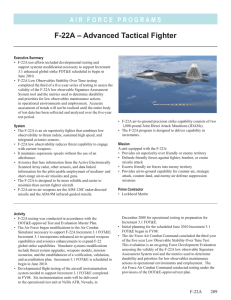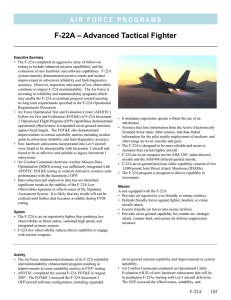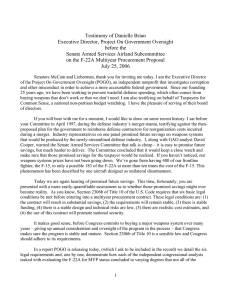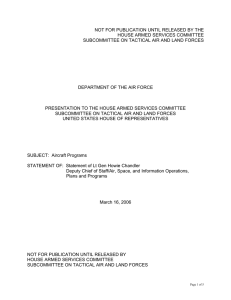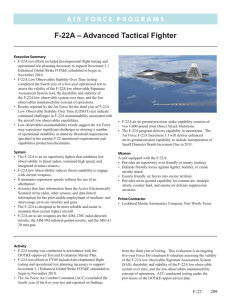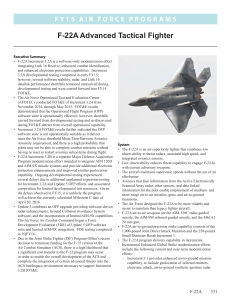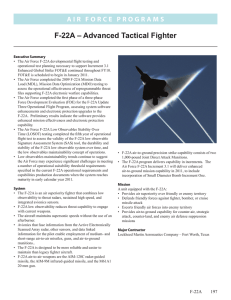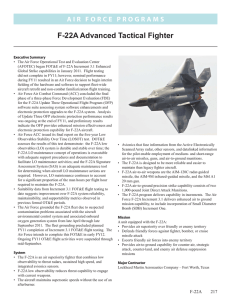A i r F o r c e ...
advertisement
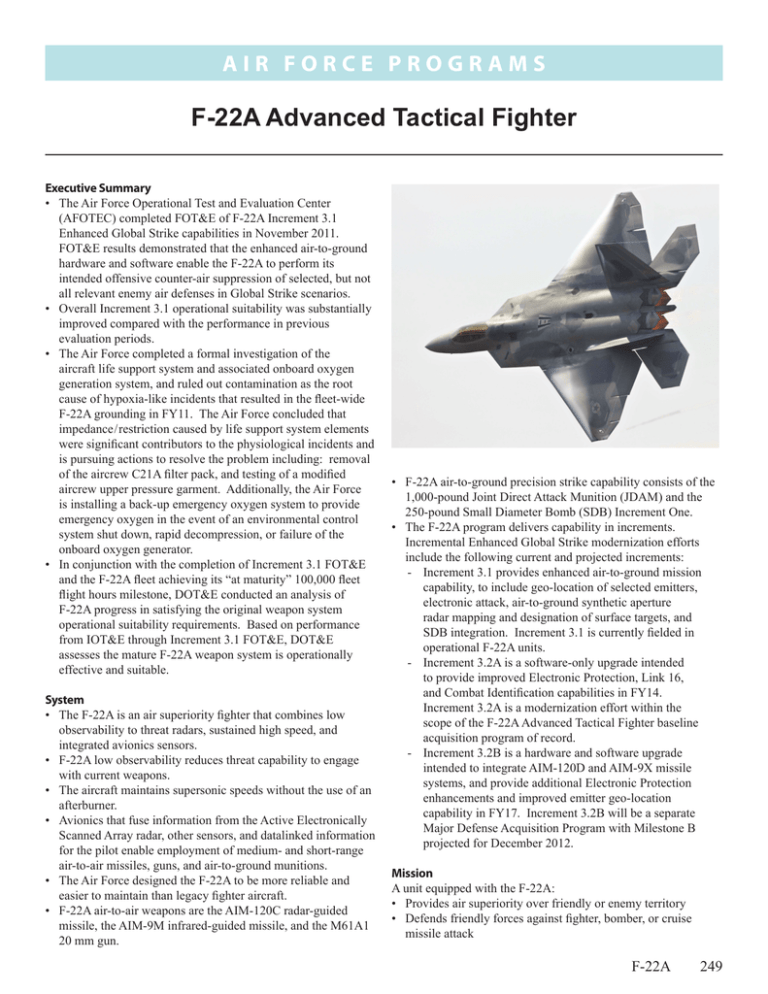
A i r F o r c e P RO G R A M S F-22A Advanced Tactical Fighter Executive Summary • The Air Force Operational Test and Evaluation Center (AFOTEC) completed FOT&E of F-22A Increment 3.1 Enhanced Global Strike capabilities in November 2011. FOT&E results demonstrated that the enhanced air-to-ground hardware and software enable the F-22A to perform its intended offensive counter-air suppression of selected, but not all relevant enemy air defenses in Global Strike scenarios. • Overall Increment 3.1 operational suitability was substantially improved compared with the performance in previous evaluation periods. • The Air Force completed a formal investigation of the aircraft life support system and associated onboard oxygen generation system, and ruled out contamination as the root cause of hypoxia-like incidents that resulted in the fleet-wide F-22A grounding in FY11. The Air Force concluded that impedance / restriction caused by life support system elements were significant contributors to the physiological incidents and is pursuing actions to resolve the problem including: removal of the aircrew C21A filter pack, and testing of a modified aircrew upper pressure garment. Additionally, the Air Force is installing a back-up emergency oxygen system to provide emergency oxygen in the event of an environmental control system shut down, rapid decompression, or failure of the onboard oxygen generator. • In conjunction with the completion of Increment 3.1 FOT&E and the F-22A fleet achieving its “at maturity” 100,000 fleet flight hours milestone, DOT&E conducted an analysis of F-22A progress in satisfying the original weapon system operational suitability requirements. Based on performance from IOT&E through Increment 3.1 FOT&E, DOT&E assesses the mature F-22A weapon system is operationally effective and suitable. System • The F-22A is an air superiority fighter that combines low observability to threat radars, sustained high speed, and integrated avionics sensors. • F-22A low observability reduces threat capability to engage with current weapons. • The aircraft maintains supersonic speeds without the use of an afterburner. • Avionics that fuse information from the Active Electronically Scanned Array radar, other sensors, and datalinked information for the pilot enable employment of medium- and short-range air-to-air missiles, guns, and air-to-ground munitions. • The Air Force designed the F-22A to be more reliable and easier to maintain than legacy fighter aircraft. • F-22A air-to-air weapons are the AIM-120C radar-guided missile, the AIM-9M infrared-guided missile, and the M61A1 20 mm gun. • F-22A air-to-ground precision strike capability consists of the 1,000-pound Joint Direct Attack Munition (JDAM) and the 250-pound Small Diameter Bomb (SDB) Increment One. • The F-22A program delivers capability in increments. Incremental Enhanced Global Strike modernization efforts include the following current and projected increments: - Increment 3.1 provides enhanced air-to-ground mission capability, to include geo-location of selected emitters, electronic attack, air-to-ground synthetic aperture radar mapping and designation of surface targets, and SDB integration. Increment 3.1 is currently fielded in operational F-22A units. - Increment 3.2A is a software-only upgrade intended to provide improved Electronic Protection, Link 16, and Combat Identification capabilities in FY14. Increment 3.2A is a modernization effort within the scope of the F-22A Advanced Tactical Fighter baseline acquisition program of record. - Increment 3.2B is a hardware and software upgrade intended to integrate AIM-120D and AIM-9X missile systems, and provide additional Electronic Protection enhancements and improved emitter geo-location capability in FY17. Increment 3.2B will be a separate Major Defense Acquisition Program with Milestone B projected for December 2012. Mission A unit equipped with the F-22A: • Provides air superiority over friendly or enemy territory • Defends friendly forces against fighter, bomber, or cruise missile attack F-22A 249 A i r F o r c e P RO G R A M S • Escorts friendly air forces into enemy territory • Provides air-to-ground capability for counter-air, strategic attack, counter-land, and enemy air defense suppression missions Activity • The Air Force conducted F-22A testing in accordance with the DOT&E-approved Test and Evaluation Master Plan (TEMP) and FOT&E plans. • The Air Force completed F-22A Increment 3.1 FOT&E in November 2011. Fleet-wide Increment 3.1 retrofits of Block 30 F-22As were ongoing throughout FY12. • The Air Force completed a formal investigation of the aircraft life support system and associated onboard oxygen generation system due to several unexplained hypoxia-like incidents that occurred throughout FY11. Fleet-wide F-22A grounding from April through September 2011 delayed the planned completion of Increment 3.1 FOT&E until November 2011. The Air Force investigation ruled out contamination as the root cause of the incidents. As of August 2012, the Air Force concluded that impedance/restriction caused by life support system elements were significant contributors to the physiological incidents. Accordingly, the Air Force is pursuing the following actions in the interest of resolving the problem: removing the aircrew C21A filter pack, and testing a modified aircrew upper pressure garment. Additionally, the Air Force is installing a back-up emergency oxygen system to provide emergency oxygen in the event of an environmental control system shut down, rapid decompression, or failure of the onboard oxygen generator. • The Air Force conducted planning activities in support of Increment 3.2A and 3.2B modernization efforts. Increment 3.2A developmental testing will begin in FY13. In conjunction with the completion of Increment 3.1 FOT&E and the F-22A fleet achieving its “at maturity” 100,000 fleet flight hours milestone, DOT&E conducted an analysis of F-22A progress in satisfying the original weapon system operational suitability requirements. Assessment Increment 3.1 FOT&E • Results of Increment 3.1 FOT&E testing completed in November 2011 demonstrated that the enhanced air-to‑ground capabilities enable the F-22A to perform its intended offensive counter-air suppression of enemy air defenses mission in Global Strike scenarios. -- The F-22A remains capable of effectively employing legacy JDAM, AIM-9M, and AIM-120C weapons as well as the newly incorporated SDB. -- Aircrews are capable of using the F-22A radar and onboard sensors to reliably locate and designate surface targets with sufficient accuracy to effectively employ both legacy JDAM and newly incorporated SDB munitions to suppress selected, but not all relevant enemy air defenses. 250 F-22A Major Contractor Lockheed Martin Aeronautics Company – Fort Worth, Texas -- O verall Increment 3.1 operational suitability was substantially improved compared with the performance in previous evaluation periods. FOT&E demonstrated a significant improvement in Mean Time Between Critical Failure (MTBCF) compared to previous OT&E periods. Increment 3.1 FOT&E MTBCF was 4.68 hours (4.01 hours 80 percent lower confidence bound; 5.26 hours 80 percent upper confidence bound) compared to the reported MTBCF in the FY07 FOT&E of 1.73 hours. -- The Increment 3.1 F-22A weapons system exceeded the operational deployability threshold requirement of seven C-17 airlift equivalents by one additional C-17. -- The Increment 3.1 F-22A weapons system met both combat sortie generation requirements and material availability threshold requirements. F-22A System At Maturity Assessment • In conjunction with the completion of Increment 3.1 FOT&E, DOT&E assessed F-22A progress since the completion of IOT&E in satisfying the original weapon system’s operational effectiveness and suitability requirements. Findings include the following: -- Based on performance from IOT&E through Increment 3.1 FOT&E, DOT&E assesses the mature F-22A weapon system as operationally effective in both air-to-air and air-to-ground mission roles. -- DOT&E compared Increment 3.1 FOT&E suitability results with operational F-22A unit performance through an independent model that simulated the combat sortie generation operations of an operational F-22A squadron. Based on suitability results achieved during Increment 3.1 FOT&E and results of the DOT&E model, DOT&E assesses that the mature F-22A weapons system is operationally suitable. -- The Air Force has matured maintenance practices, improved subsystem suitability, adjusted manpower requirements, and modified the F-22A deployment concept of operations in order to meet F-22A combat air power needs. The F-22A weapons system is capable of achieving material availability and combat sortie generation Key Performance Parameter thresholds. However, based on increased maintenance manpower, equipment, and supplies necessary to sustain combat operations, the Air Force is likely to continue to require eight C-17 airlift equivalents to deploy an F-22A squadron in support of global operations. A i r F o r c e P RO G R A M S Recommendations • Status of Previous Recommendations. The Air Force continues to address all previous recommendations. • FY12 Recommendation. 1. Commensurate with the maturation of the F-22A weapons system and ongoing F-22A modernization efforts, the Air Force should apply past lessons learned for forthcoming F-22A upgrades, and the development and fielding of future manned fighter aircraft programs. Particular attention should be given to the challenges of maintaining low observable systems. F-22A 251 A i r F o r c e P RO G R A M S 252
